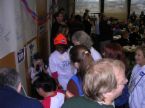The Presidential Primary Elections
|

|
|
Share This Page
|
|
|
|
|
|
|
Follow This Site

|
 |
|
|
|
|

|
Part 2: How It All Ends Up
A caucus is something remarkably different. People in states that have a caucus do indeed vote, but they don't cast ballots. Rather, they gather in public places (like schools, churches, and public libraries) and do more than just vote for candidates. People who attend a caucus discuss important issues for the presidential campaign and for their own state's agenda.
The most notable caucus is in Iowa because it is the first such caucus held in a presidential election year. Many other states have caucuses, and they all run a little differently.
The Iowa Caucuses are different for Republicans and Democrats. The Republican  caucus is simpler than the Democratic one. At the Republican caucus, people gather in their public places and write their preferred candidate's name on a blank sheet of paper. Votes are tallied, and a winner is named.
caucus is simpler than the Democratic one. At the Republican caucus, people gather in their public places and write their preferred candidate's name on a blank sheet of paper. Votes are tallied, and a winner is named.
The Democratic caucus in Iowa has many layers. First of all, people show up and stand in a designated area, like a corner of a room, in order to show their support for a particular candidate. Those who aren't convinced by any candidate so far stand in a separate area. Then, for 30 minutes, representatives of a particular candidate's campaign (or sometimes the candidate himself or herself) try to convince the undecided voters to support him or her.
At the end of the 30 minutes, voters get a  chance to change areas if they have been convinced to support a candidate or have decided to go with a different candidate than the one with which they started. At that point, political party officials count the number of people in each area. The candidates with the fewest votes lose their designated areas, and the voters who had stood in those areas are then free to stand in other areas, supporting other candidates. Another 30-minute session takes place, and candidates or their representatives are again given the opportunity to convince voters to vote a certain way.
chance to change areas if they have been convinced to support a candidate or have decided to go with a different candidate than the one with which they started. At that point, political party officials count the number of people in each area. The candidates with the fewest votes lose their designated areas, and the voters who had stood in those areas are then free to stand in other areas, supporting other candidates. Another 30-minute session takes place, and candidates or their representatives are again given the opportunity to convince voters to vote a certain way.
The final head count determines the "winner" (although, as we have seen, the "losers" don't really lose – they just get fewer delegates at the national political party convention).
First page > How It Starts > Page 1, 2



 caucus is simpler than the Democratic one. At the Republican caucus, people gather in their public places and write their preferred candidate's name on a blank sheet of paper. Votes are tallied, and a winner is named.
caucus is simpler than the Democratic one. At the Republican caucus, people gather in their public places and write their preferred candidate's name on a blank sheet of paper. Votes are tallied, and a winner is named. chance to change areas if they have been convinced to support a candidate or have decided to go with a different candidate than the one with which they started. At that point, political party officials count the number of people in each area. The candidates with the fewest votes lose their designated areas, and the voters who had stood in those areas are then free to stand in other areas, supporting other candidates. Another 30-minute session takes place, and candidates or their representatives are again given the opportunity to convince voters to vote a certain way.
chance to change areas if they have been convinced to support a candidate or have decided to go with a different candidate than the one with which they started. At that point, political party officials count the number of people in each area. The candidates with the fewest votes lose their designated areas, and the voters who had stood in those areas are then free to stand in other areas, supporting other candidates. Another 30-minute session takes place, and candidates or their representatives are again given the opportunity to convince voters to vote a certain way.
